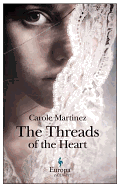
| Publisher: | Europa Editions | |
| Genre: | Fiction, Occult & Supernatural, Family Life, Literary | |
| ISBN: | 9781609450878 | |
| Pub Date: | December 2012 | |
| Price: | $17 |
| Starred | Fiction |
by Carole Martinez, trans. by Howard Curtis
Frasquita has been given a gift that has passed down through the women in her family for generations. The gift comes in a small box that must be kept closed for nine months before revealing its treasure; when Frasquita opens it, she finds a sewing kit with threads of the most marvelous colors. For the rest of her life, she possesses unparalleled skill with the needle, creating for herself a wedding dress that draws beauty from the world, stitching a man back to his lost shadow, even sewing together her husband's rooster after it loses a cock fight. Frasquita's gift quickly becomes a curse, however, as her friends and neighbors brand her a sorceress and her husband descends into madness. And so she flees her small town, taking her five children, her sewing kit and her hopes of sparing her daughters her own horrible fate.
Carole Martinez's Threads of the Heart, a bestseller in Europe, tells Frasquita's story from the eyes of a daughter attempting to lay her mother's memory to rest. Martinez gives readers a whimsical, heartbreaking story of love and spells and beauty in which magic and reality are woven so tightly together that the two become inextricable. The result is a novel at once mythical in its scope and haunting in its realism, sure to be remembered long past the turn of the last page. --Kerry McHugh, blogger at Entomology of a Bookworm

| Publisher: | Pamela Dorman/Viking | |
| Genre: | Fiction, Romance, Contemporary Women, Contemporary | |
| ISBN: | 9780670026609 | |
| Pub Date: | December 2012 | |
| Price: | $27.95 |
| Starred | Fiction |
by Jojo Moyes
Jojo Moyes's Me Before You is a wistful modern retelling of Beauty and the Beast with an ethical conundrum at its core. When Louisa Clark loses her job waiting tables at a local café, she's desperate to find work and winds up taking a position as caretaker to a quadriplegic man. Given her lack of health care experience, Louisa can't understand why the family would hire her. Then she meets the patient.
Will Traynor's fast-paced life of big business, international travel and daredevil hobbies ended when a motorcycle accident left him paralyzed below the shoulders; he's become caustic, withdrawn and nearly unbearable. When Louisa finds out he plans to commit assisted suicide in six months, her first instinct is to quit, but instead she sets out to change his mind with a hit-and-miss series of adventures that ultimately brings her out of her own shell. Before she knows it, saving Will's life is intimately connected to saving herself from heartbreak.
Given her chirpy personality, quirky sense of humor and enormous capacity for compassion, it's no surprise even moody, sarcastic Will finds Louisa irresistible. And though he never completely loses his edge, once Will lets his guard down, he's as charming and eloquent a hero as any romance reader could wish for. While the story contains several "pass the Kleenex" moments, the romance between these two irrepressible souls only intensifies the novel's core question: at what point should a disabled person's friends and family acknowledge that if he can no longer control his life, he should be allowed to end it? --Jaclyn Fulwood, youth services manager, Latah County Library District; blogger at Infinite Reads
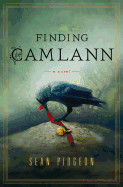
| Publisher: | W.W. Norton | |
| Genre: | General, Biography & Autobiography | |
| ISBN: | 9780393073294 | |
| Pub Date: | January 2013 | |
| Price: | $26.95 |
| Fiction |
by Sean Pidgeon, Charles Fenn
What's Camlann, you ask? It's where King Arthur fought and died, run through by his enemy Mordred's sword. That's what the legend tells us, but no one is sure where Camlann is. Debut novelist Sean Pidgeon approaches the subject from a different angle in Finding Camlann. It's part love story, part literary suspense, part archeology quest... but all Welsh.
Archeologist Donald Gladstone hopes to publish a book about the "real" Arthur, as revealed in the literary and historical record. He hears news of an exciting archeological discovery at Devil's Barrow near Stonehenge--bones of ancient fighters and a "magical chalice" that might be the Holy Grail. Could it be the burial site for Arthur and Guinevere? Add to this his discovery of an old Welsh poem about Arthur that seems to contain a geographical reference to the Barrow. Then add Julia Llewellyn, who works at the Oxford English Dictionary and is fluent in Old and Middle Welsh. Pidgeon weaves an intricate tale drawing on literature, dusty manuscripts and variant translations of ancient texts. Then there's the geography of Wales, which plays a significant role in the novel, as does the historical undercurrent of Welsh hatred for all things English. There's also a mysterious group of militant Welsh nationalists, to which Hugh may belong.
Finding Camlann shares plot elements similar to those of a Dan Brown novel, but it's more like Umberto Eco's The Name of the Rose in terms of the serious, sometimes arcane way it involves the reader in scholarly and historical matters. Although the romance part of Pidgeon's tale doesn't quite catch fire, readers interested in a thoughtful mystery with strong literary underpinnings will enjoy the bookish puzzles hidden within. --Tom Lavoie, former publisher

| Publisher: | Harper | |
| Genre: | Fiction, Coming of Age, Family Life, Literary | |
| ISBN: | 9780062209849 | |
| Pub Date: | January 2013 | |
| Price: | $25.99 |
| Fiction |
by Lisa O'Donnell
It's Christmas Eve in Scotland: 15-year-old Marnie and her 12-year-old sister, Nelly, have just finished burying their parents in the back garden, and they have no one to turn to but the kindly old sex offender who lives next door. Sound familiar? Didn't think so.
Lisa O'Donnell's wildly original debut The Death of Bees examines the intricacies of betrayal and loyalty within one family. Marnie and Nelly are used to a life of abuse and neglect, though only they know the fact and manner of their parents' deaths. Marnie fears they will be separated and put into foster care if the authorities learn their parents are dead. Desperate for food and adult guidance, the girls take shelter with their elderly neighbor Lennie, a gay man who became a registered sex offender when he was caught soliciting sex from a boy he didn't realize was underage. Lonely Lennie gladly plays along, cooking them meals, accompanying aspiring violinist Nelly on the piano, even pretending to be their uncle for the benefit of school administrators.
Unfortunately, their fragile idyll cannot last. Since neither girl expects anyone to miss their lowlife parents, they're surprised when their estranged grandfather comes to town to make amends--and dismayed when he turns out to be the polar opposite of fatherly Lennie. Part coming-of-age tale, part seedy urban drama, and part testament to the sibling bond, this darkly introspective and clever novel juxtaposes sisters who shield themselves from a harsh life in very different ways. O'Donnell's debut is a gritty but redemptive take on family and the price of secrets. --Jaclyn Fulwood, youth services manager, Latah County Library District; blogger at Infinite Reads
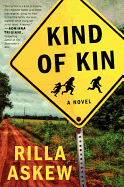
| Publisher: | Ecco | |
| Genre: | Fiction, Contemporary Women, Family Life | |
| ISBN: | 9780062198792 | |
| Pub Date: | January 2013 | |
| Price: | $25.99 |
| Fiction |
by Rilla Askew
Rilla Askew (The Mercy Seat) steps out of her usual historical fiction with Kind of Kin, a novel that touches on both the timeless theme of family bonds and the timely theme of illegal immigration.
Bob Brown's arrest shocks the citizens of tiny Cedar, Okla. In an exercise in radical Christian discipleship, Bob sheltered a handful of frightened illegal Mexican immigrants in his barn, only to find himself betrayed to the law by someone close to him. In his absence, his daughter, Sweet, takes over the care of her orphaned nephew, Dustin--one more worry for a woman already dealing with a tight household budget, her husband's constant trips for his job and a son even she admits is turning into a bully. When Dustin runs away, Sweet finds herself in the middle of a media circus, just as Dustin's older sister comes seeking shelter for her husband, who's returned to the U.S. after being deported to Mexico.
Askew's vividly authentic portrayal of small-town, working-class Oklahomans encompasses their gossipmongering and fear of the unknown without mockery, along with rendering their core values, tenacious spirit and bone-deep sense of hospitality without becoming trite or twee. In Kind of Kin, she has crafted an uncannily real cast of characters whose attempts to go about their daily lives intersect with religious and political issues and the choice between the right way and the easy way. Her sensitive and humanizing treatment of this hot-button issue is sure to provoke thought and discussion no matter the reader's political leanings. --Jaclyn Fulwood, youth services manager, Latah County Library District; blogger at Infinite Reads
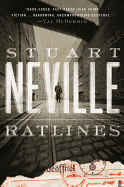
| Publisher: | Soho Crime | |
| Genre: | General, Fiction, Mystery & Detective, Thrillers, Historical, Hard-Boiled | |
| ISBN: | 9781616952044 | |
| Pub Date: | January 2013 | |
| Price: | $26.95 |
| Mystery & Thriller |
by Stuart Neville
The title of Stuart Neville's standalone thriller Ratlines refers to the underground network that helped former Nazis and their associates escape Germany after the Second World War, one of which led to the Republic of Ireland, which remained neutral during the war. The year is 1963: President Kennedy is planning a visit to his ancestral country, and Nazi war criminals living there are being murdered. The nation's Minister for Justice orders Lieutenant Albert Ryan, an agent in the Directorate of Intelligence, to investigate the killings. Ryan doesn't like the assignment much, especially since he has to protect the next threatened target, the real-life figure Otto Skorzeny, a ruthless man and commando most famous for rescuing Mussolini in 1943 who plays an important role in the ratline network. Ryan finds that the lines between right and wrong are muddled, and the only moral compass he can follow is his own.
Set in a time when James Bond was becoming popular, Neville's lean, mean prose tells a brutal story that's the opposite of 007--glossy but no less captivating. At first, Ryan seems like a rules-following government flack, but readers discover what he's made of when the bad guys mess with people close to him. Ryan takes matters into his hands, exposing a side that's dangerous--and exciting. He encounters some really nasty characters besides Skorzeny, but going up against them only makes his formidableness grow. He may struggle with crises of conscience, but readers will probably be squarely on his side and rooting for him to return in future novels. --Elyse Dinh-McCrilllis, freelance writer/editor, blogging at Pop Culture Nerd.
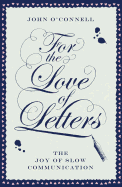
| Publisher: | Atria | |
| Genre: | Literary Criticism, Literary Collections, General, Language Arts & Disciplines, Writing Skills, Reference | |
| ISBN: | 9781476718804 | |
| Pub Date: | January 2013 | |
| Price: | $20 |
| Nonfiction |
by John O'Connell
In this day of fast correspondence via e-mails and tweets, John O'Connell takes a refreshing look at the history behind the deliberate and genteel skills of letter-writing in For the Love of Letters. Examples of letters written by noteworthy people such as Dorothy Wordsworth (sister to William) demonstrate how far the world has changed since 1806; her letter, announcing the birth of a child, runs for two pages and details "the birds singing in the orchard in full assembly" and "the rose-trees rich with roses in the garden, the sun shining on the mountain, the air still and balmy." Today, the same birth announcement would be squashed into 140 characters.
O'Connell analyzes the epistolary techniques of other famous writers, including Jonathan Swift, Jane Austen and Anton Chekhov. Their letters cover the general news of the day, arguments, friendships, love and advice from a parent to a child--showing the slow, thoughtful process that each writer assumed in order to produce such correspondence. A passage from Catherine Field sums up the joy and meticulousness inherent in letter-writing: "A good handwritten letter is a creative act," she said, "and not just because it is a visual and tactile pleasure. It is a deliberate act of exposure, a form of vulnerability, because handwriting opens a window on the soul in a way that cyber-communication can never do." O'Connell's book finds compassion buried in the words and allows readers a warmhearted glimpse at a custom that is rapidly disappearing. --Lee E. Cart, freelance writer and book reviewer

| Publisher: | Viking | |
| Genre: | Psychology, Cognitive Psychology | |
| ISBN: | 9780670026579 | |
| Pub Date: | January 2013 | |
| Price: | $26.95 |
| Psychology & Self-Help |
by Maria Konnikova
With Mastermind, Maria Konnikova (who writes the "Literally Psyched" column in Scientific American) promises to teach us how to think like Sherlock Holmes. Though the great detective might have been fiction, she argues, "his rigorous approach to thought was very real indeed."
It all starts with understanding our brains and their biases and their annoyingly practical tendency to choose the easiest path in any given situation. Once we understand those habits, we can work to change them, starting with observing the world around us more closely and purposefully, then moving on to combining that observation with imagination of what could be or could have been. From there, the art of deduction flows naturally, further proving Holmes's constant claim that "when you have eliminated the impossible, whatever is left, no matter how improbable, must be the truth."
Though it can feel repetitive at times, Mastermind ultimately succeeds in helping readers to understand better how Holmes is able to think the way he does--though putting it into practice ourselves may prove harder than it sounds. Mastermind draws on many examples from the Holmes canon, and so will be best appreciated by those already familiar with Sir Arthur Conan Doyle's stories; others may struggle fully to appreciate Konnikova's examples from the texts or be disappointed to encounter the outcome of a story before having enjoyed it themselves. --Kerry McHugh, blogger at Entomology of a Bookworm

| Publisher: | Skirt! | |
| Genre: | General, Love & Romance, Psychology, Self-Help, Human Sexuality, Family & Relationships | |
| ISBN: | 9780762782093 | |
| Pub Date: | January 2013 | |
| Price: | $14.95 |
| Psychology & Self-Help |
by Jess McCann
Reading Was It Something I Said? is like having a wise, compassionate friend on speed-dial, ready to respond to any dating dilemma with just the right advice. Prior to becoming a dating coach, Jess McCann started her own successful sales company, eventually deciding to channel her energies into helping women find love. Her first book, You Lost Him at Hello, provided a general game plan to finding love and sparked many e-mails and letters about specific situations. Though she had "provided an all-over dating strategy" for her readers, McCann later realized "what they needed were tactics," and she was happy to oblige.
McCann covers how to keep a potential date interested in the age of all-access communication, including how to respond to "sexting" and how to move from texting to dating. Each section begins with a quick overview of the topic ("hooking up" or "social networking" etiquette, for example) and then proceeds to answer questions from readers: "Should I text him first? What should I say?" McCann's answers are direct and concrete, informed by her own pre-matrimony experiences as well as those from other clients.
McCann reminds her readers that "your goal should be to keep him interested long enough to evaluate the most critical element of a happy, healthy relationship: determining whether he is not only the right person for you but a good person in general." Was It Something I Said? will help single women do just that. --Kristen Galles, blogger at Book Club Classics

| Publisher: | Oxford University Press | |
| Genre: | Conceptual, Art, General, Techniques, Business Aspects | |
| ISBN: | 9780199928354 | |
| Pub Date: | January 2013 | |
| Price: | $19.95 |
| Art & Photography |
by Jonathon Keats
"No authentic masterpiece is as provocative as a great forgery. Forgers are the foremost artists of our age," art critic and conceptual artist Jonathon Keats writes in the fascinating Forged. "A forgery is alive with meaning."
Fakes have been around for centuries: one of the first artists to be forged was St. Luke, whose "supposed" portrait of Mary with child, the Hodegetria, was said to work miracles; even the copies of it could work miracles. It was one of Constantinople's most popular attractions until it was destroyed when the city fell to the Turks--but was it really destroyed, or could the original be one of the many "fakes" in circulation? Then there's the case of Michelangelo, who borrowed a painting by a master that he really liked--then returned a copy, keeping the original. His friend couldn't tell the difference.
Keats examines six master forgers of the 20th century. There's the German Lothar Malskat, who was asked to help restore murals damaged by war bombs. Instead, he repainted them, even creating a few new murals of his own. Eric Hebborn forged paintings and sculptures and wrote a book about it, The Art Forger's Handbook. Then there's the enigmatic Elmyr de Hory, subject of an Orson Welles's documentary, whose fake moderns were in museums around the world.
Keats concludes with a stimulating chapter about da Vinci, Warhol and "appropriation," in which legitimate artists' original creations technically come closest to forgery. Subversive indeed. --Tom Lavoie, former publisher
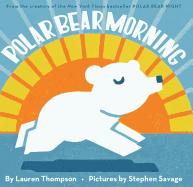
| Publisher: | Scholastic | |
| Genre: | Animals, Juvenile Fiction, Bears | |
| ISBN: | 9780439698856 | |
| Pub Date: | January 2013 | |
| Price: | $16.99 |
| Starred | Children's & Young Adult |
by Lauren Thompson, illust. by Stephen Savage
After exploring a polar bear cub's first yearnings of independence in Polar Bear Night, Lauren Thompson and Stephen Savage now chronicle the cub as she makes her first friend.
Author and artist once again use a spare text and graphic shapes to stellar effect, as the furry heroine leaves her sleeping mother to follow the call of the seagulls and investigate her surroundings. Steven Savage's linocut illustrations move from the icy blues of the cold polar region to the pink light of dawn in an aerial view of the seagulls circling above the cub: "The polar bear cub watches, wondering." Her curiosity leads her to "a snowy something" tumbling down a hill. The polar cub comes snout to snout with a "snow cub," its fur frosted with snowflakes. As the pair scamper and sprint, they pass other creatures from the previous book: a family of seals, a walrus. Together the cubs jump into the sea, and a stunning array of blue and teal hues shows the sun's rays penetrating the surface and the bears' synchronized trail of bubbles.
When they come up for air, the heroine's mother watches from the shore. The whale and seals, too, surround the polar bear cub and her snow cub friend, in a lovely echo of the stars that "light up everything the little bear loves" in Polar Bear Night. Thompson and Savage beautifully capture the feeling that friendship opens up a whole new world under a "wide, blue sky." --Jennifer M. Brown, children's editor, Shelf Awareness
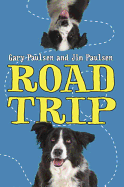
| Publisher: | Wendy Lamb/Random House | |
| Genre: | General, Juvenile Fiction | |
| ISBN: | 9780385741910 | |
| Pub Date: | January 2013 | |
| Price: | $12.99 |
| Children's & Young Adult |
by Gary Paulsen, Jim Paulsen
This collaboration by a father-and-son team starts as a rescue mission for a dog and winds up saving two teens as well.
Ben's father wakes him up on the first day of summer vacation, and by 5:17 a.m., Ben and his dad are on their way to rescue a border collie puppy. On the front seat between them sits Atticus, the border collie who's been part of the family since before 14-year-old Ben was born. There's another reason for the trip: Ben's dad quit his job as a v-p at an insurance company to "flip houses," and he breaks the news that the money's not there to send Ben to hockey camp. Ben slaved to get all A's--his part of their agreement. The air is thick between them as their pick-up truck heads toward their destination.
The Paulsens realistically convey how Ben's anger colors his actions. Ben surreptitiously invites along another passenger, Theo, whom his father calls "the hoodlum"--an 18-year-old "cool" guy Ben tutored so he could graduate. When their truck breaks down, Ben also invites along Gus, the mechanic whose bus they borrow to complete their journey. Mia, a teenage waitress they meet on the road, joins the entourage, too.
Ben and Atticus narrate in alternating chapters. Atticus's sections fill in details others miss and break the tension between father and son. Suspense mounts as Theo's past has an impact on their journey. This is a fun, breezy read for dog lovers and fans of Gary Paulsen's (Hatchet) other adventures. --Jennifer M. Brown, children's editor, Shelf Awareness